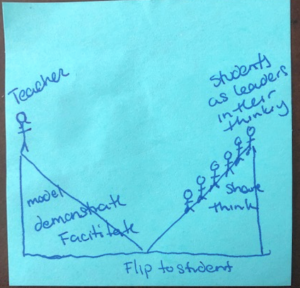I received this text message at 10:30 pm on a fall night from my freshman son at Colorado State University (CSU). In a flash, my husband and I were on the phone with Noah, who described the event as surreal. His buddies volunteered him to go out on the field during a football game and try to kick a 25-yard field goal for a contest. He noted how imitating it was to have so many eyes watching him as he jogged to 25-yard line in his green and yellow overalls and high top shoes. Obviously, not ideal kicking attire. The ref put the football on a tee and said, “Go for it!” No time for a warm-up, he had to be on his game right out of the gate.
Noah’s strategy was to flip a mental switch, silence the crowd and focus solely on his thoughts. He thought about his kicking techniques from his years playing soccer and envisioned himself sequencing the skills. He turned focus into action and in a blink, Noah’s mind switched back from that quiet space to a stadium full of screaming students. The ball was soaring through the uprights, in the middle of the goal – he was exhilarated!
Susan McIvar, a first grade teacher at Little Elementary in the Jeffco School District, uplifts the same exhilarating experience for educators when they observe her in action with her students. As a Public Education & Business Coalition (PEBC) Lab Host, Susan opens her classroom several times a year for others to see her instructional moves and observe students doing the thinking. Like Noah, Susan turns the outside world off and creates magical moments where she enables students to drive their own learning and hold identities as readers and writers.
PEBC Lab Host puts themselves out on the field for others to see. Many observations end with a moment of gratitude to the host for their courage, brilliance, and gifts. I am on a journey of thinking about ways to show appreciation to our amazing hosts by having them see the impact they make on teachers and students. Below are three ideas that highlight application with appreciation for peer observations and create an opportunity for the hosting teacher to see and hear their impact.

The Picture of Thanks
The Picture of Thanks
This experience invites educators to capture, in one sticky note, a picture that represents one instructional move the host teacher did that they will implement back at their school or district. I have been told the specific details go deeper than a “thank you,” it shows the “why” we are in this profession, to make a difference for kids!
The Boomerang Effect
This idea invites an educator to reflect on ideas days or weeks after the observation. On a paper boomerang, observers write one idea they want to try. They include specific steps to make it happen in their classroom or school and why it will be important for their students. They then have one month to reflect on the application, write it on the back of the boomerang, and return it to the host teacher. This reminds the host teacher weeks later about the impact of their lesson and might give them ideas to implement as well!
Two Reasons Why You Should Blush Today
This activity cultivates an opportunity for the observers to be specific about two things they saw and heard that were important for students and their learning.
Example
Two Reasons Why You Should Blush Today
1. Asking open-ended questions encouraged students to explain their thinking as a reader. “What are you noticing about this character?” “What are some of your hunches about how he might feel about his family?”
2. Each student had time to think before they shared with a partner. This gave them time to collect their thinking before having to share. The conversations went on longer and fifteen students were able to provide more examples to support their thinking.
These closings can create a whole different layer of purpose for a host teacher. It reminds them of the power of learning from each other and why it can be one of the most powerful ways to learn and grow as a lifelong learner.
You might be wondering if Noah really bought the 1,000 donuts with his money. He bought four dozen for him and his buddies to share. Just like hosting a lab, your gifts are shared with others and people place the new leaning in their filing cabinets, in their minds, to be retrieved the next day or months from now.
I encourage you, as a facilitator, to continue to think about new exhilarating ideas that make the host hear the crowd and know they are impacting the lives of many students.

